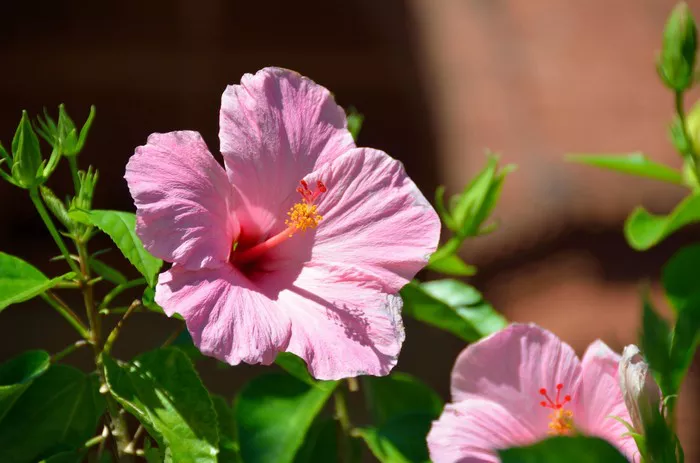Hibiscus, with its vibrant and often large blooms, is a beloved flowering plant found in gardens and landscapes around the world. Known for its diverse colors and striking appearance, the hibiscus flower (Hibiscus spp.) is not only aesthetically pleasing but also carries cultural and medicinal significance in various cultures. One of the common questions among gardeners and enthusiasts alike is how long these beautiful flowers actually bloom. This article aims to delve into the factors influencing the bloom duration of hibiscus, the different species variations, and practical tips for extending their flowering period.
Hibiscus: Diversity and Characteristics
Hibiscus belongs to the family Malvaceae and encompasses hundreds of species, ranging from perennial shrubs to small trees. The most widely cultivated species include Hibiscus rosa-sinensis (Chinese hibiscus) and Hibiscus syriacus (Rose of Sharon), each known for their distinctive flower shapes and colors. Hibiscus flowers typically feature five petals that form a trumpet-like shape, often with a prominent stamen extending from the center. Colors can range from bright reds, pinks, and oranges to more subdued whites and yellows, making hibiscus a versatile choice for gardeners seeking vibrant displays.
Factors Influencing Bloom Duration
Several factors play crucial roles in determining how long hibiscus flowers bloom. Understanding these factors can help gardeners manage their plants effectively and optimize flowering periods:
Species and Varieties: Different species and cultivars of hibiscus exhibit varying bloom durations. For instance, tropical hibiscus (Hibiscus rosa-sinensis) tends to have longer blooming periods compared to hardy hibiscus (Hibiscus syriacus), which blooms intermittently throughout the summer.
Climate and Growing Conditions: Climate influences flowering patterns significantly. Tropical varieties thrive in warm, humid conditions and may bloom year-round in suitable climates. In contrast, temperate hibiscus species require warmer temperatures to initiate blooming and may cease flowering during colder seasons.
Light Requirements: Adequate sunlight is essential for hibiscus to bloom profusely. Most varieties prefer full sun but can tolerate partial shade. Insufficient light can result in reduced flowering or failure to bloom altogether.
Watering and Soil Quality: Hibiscus plants prefer consistently moist, well-drained soil. Irregular watering or waterlogged conditions can stress the plant, affecting its ability to produce flowers. Additionally, nutrient-rich soil supports healthy growth and flowering.
Pruning and Maintenance: Proper pruning promotes flowering by stimulating new growth and removing dead or diseased branches. Regular maintenance, including fertilization and pest control, ensures the plant remains healthy and capable of producing flowers.
Life Cycle of a Hibiscus Flower
Understanding the life cycle of hibiscus provides insights into its blooming behavior:
Bud Formation: Hibiscus flowers develop from buds that form at the ends of new growth. Buds typically take several weeks to mature before blooming.
Blooming: Once mature, hibiscus flowers open gradually, with each bloom lasting for a few days to a week, depending on environmental conditions and species.
Fading and Seed Production: After blooming, hibiscus flowers wilt and drop petals. If pollinated, the flower develops into a seed pod containing numerous seeds. Removing spent flowers (deadheading) can encourage continuous blooming.
Dormancy and Rest Periods: Some hibiscus species enter periods of dormancy, especially in cooler climates or during adverse growing conditions. During dormancy, flowering ceases until conditions become favorable again.
SEE ALSO: Are Hibiscus Plants Poisonous to Dogs?
Common Varieties and Their Bloom Characteristics
Tropical Hibiscus (Hibiscus rosa-sinensis): Known for its large, showy flowers in shades of red, pink, orange, and yellow. Tropical hibiscus can bloom throughout the year in warm climates, with individual flowers lasting several days.
Hardy Hibiscus (Hibiscus syriacus): Also called Rose of Sharon, hardy hibiscus produces smaller, bell-shaped flowers in shades of white, pink, and purple. Bloom periods typically occur in summer and may continue sporadically into early fall.
Native Hibiscus (Hibiscus moscheutos): Native to North America, these hibiscus species produce large, colorful flowers and are well-adapted to wetland habitats. They bloom from mid to late summer and attract pollinators like bees and butterflies.
Perennial Hibiscus (Hibiscus acetosella): Characterized by deeply lobed leaves and vibrant red or burgundy flowers, perennial hibiscus blooms from midsummer to fall. It thrives in sunny locations with moist soil.
Cultivation Tips for Prolonging Hibiscus Bloom
To extend the blooming period of hibiscus and ensure abundant flowers, consider the following tips:
Plant Selection: Choose hibiscus varieties suited to your climate and growing conditions for optimal performance.
Sunlight: Provide at least 6-8 hours of direct sunlight daily for maximum bloom production.
Watering: Maintain consistent soil moisture, allowing the soil to dry slightly between watering sessions. Avoid overwatering, which can lead to root rot.
Fertilization: Apply a balanced fertilizer formulated for flowering plants during the growing season to promote healthy blooms.
Pruning: Regularly prune hibiscus to remove dead or overgrown branches, which encourages new growth and enhances flowering.
Pest and Disease Control: Monitor plants for pests like aphids and spider mites, which can affect flower production. Treat infestations promptly using appropriate methods.
Conclusion
In conclusion, the duration of hibiscus bloom varies widely depending on species, climate, and care practices. By understanding the factors influencing bloom duration and implementing appropriate cultivation techniques, gardeners can maximize the beauty and longevity of hibiscus flowers in their gardens. Whether cultivating tropical varieties for year-round color or hardy species for seasonal displays, hibiscus remains a cherished addition to any landscape, offering not only visual delight but also cultural and ecological value. With proper attention to growing conditions and maintenance, hibiscus enthusiasts can enjoy a prolonged and vibrant flowering season year after year.


